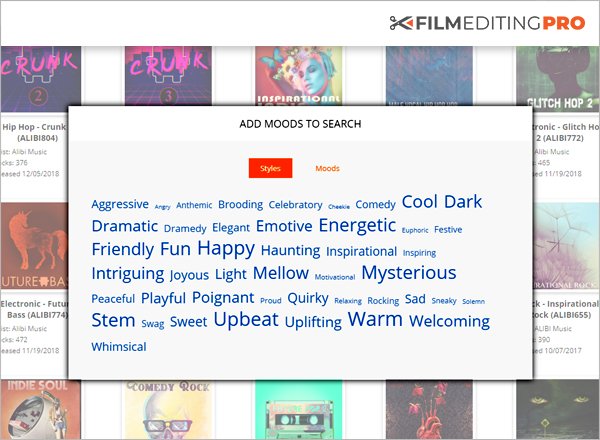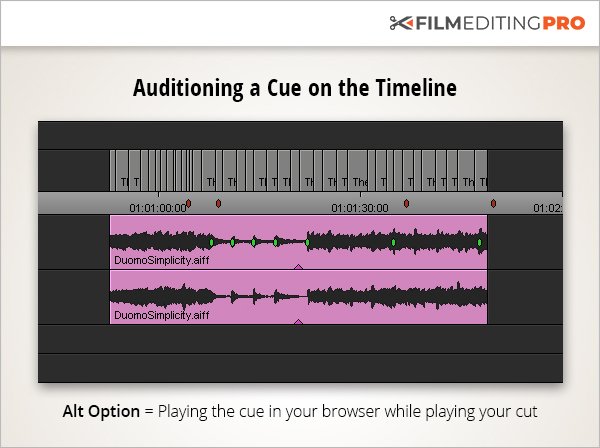So, you’ve found your first client, congratulations! After all that hard work and grind, someone…

How to Find the Perfect Music…Faster
Think about the movies, tv shows, or commercials you’ve seen. Music has probably been an integral part of the sound track. Have you ever wondered where that music came from, who produced it, and why it worked so well?
Probably not.
But now that you’re thinking about it, where did the editor get that music? Often, as in feature films, a composer scored it just for that production. But in many other cases, it came from a stock music library.
In this tutorial, you’ll learn:
- What exactly is stock music?
- Royalties vs. licensing
- The in’s and out’s of music libraries
- Searching for moods & emotions
- Tips for finding the perfect cues
- How to audition your cues
- Why melody is not (always) your friend
So, What is Stock Music?
Stock music – also known as production music, library music, or licensed music – is music composed and recorded specifically for use in other productions. At one time, this music was considered the poor relative of real listening music. You might have heard it referred to as “muzak” or “elevator music”. It was known for being trite, predictable, and dated.
Today, libraries hire talented composers and producers from around the world – some of the same people working in the record industry – to offer possibilities on par with the best listening music.
Competition and technology have led to better stock music that is more varied and easier to obtain than ever before.
Royalties vs. Licensing
Many libraries use the term “royalty free” to describe their music. This refers to the fact that you don’t pay royalties directly to songwriters and publishers to use It.
That doesn’t mean the music is free though. You do pay licensing fees.
These vary depending upon on how you use the music. In most cases, you pay once for a particular theme and can use it forever. The license is non-exclusive, which means you may hear the same cue on someone else’s production. Even though it doesn’t happen that often, it’s good to check if that might be a problem for your client before you proceed in your search!
Complete usage terms are spelled out in the fine print for the different kinds of licenses available on the cue you select. It’s not exactly light reading, but it’s important to understand how to stay on the right side of copyright laws.
The In’s and Out’s of Music Libraries
A typical online stock music library will have a search window to enter keywords and pull up themes that have been tagged with those specific terms.
You can also browse by music style, mood/emotion, production genre, or instrumentation. Each of these categories breaks down into dozens of sub-categories. A given theme is likely to be in multiple categories and sub-categories.
The reason why many libraries have similar search functions is because the ways you think about music vary, like this…
- Ambient music for an upscale bar scene would likely feature piano (instrumentation)
- Impending danger would suggest something ominous (mood/emotion)
- Cruising down the highway might need a good rock music accompaniment (music style)
- While a news feature would require…well, something newsy sounding (production genre)
Why Are Moods and Emotions So Important in a Music Search?
Of all the search categories, moods and emotions take the most getting used to. Feelings can sometimes be difficult to put into words. Fortunately, libraries are good at that. The descriptors they use tend to capture the essence of a mood or emotion very well.
For example, you’ll see words like optimistic, uplifting, determined, confident, nostalgic, introspective, and heroic in the descriptions of stock music themes today. With time, you’ll get better at using this language to describe the feeling you want to evoke. And that will make your music search go more quickly.
Tips For Finding The Perfect Cues
No matter how well a music library is set up or how much experience you have, some music searches are going to be more difficult than others for one simple reason: You won’t always know what you’re looking for.
When that’s the case, try browsing. Listen to a variety of themes across several sub-categories and stay open to what that little voice inside tells you.
Things to keep in mind:
1. Sometimes background music just needs to take up sonic space, keeping the dialogue or voiceover from sounding too naked.
2. Other times, the best choices may be the least logical. It’s called going against type. Like when you date someone who is completely different from you. It can be a perfect match!
3. The little voice in your head might also tell you that you don’t need music after all. Any good sound designer knows that ambient sound can be the most dramatic background. Plus, scenes without music give scenes with music that much more impact. No music can sometimes the best music.
How to Audition Your Cues
Regardless of how you arrive at your choices for cues, you need to observe how they interact with your cut. To do that, you’re going to audition your music cues.
Here’s two ways you could go about it:
1. Quick and easy – play the music from your browser while simultaneously playing your cut.
2. Download a demo version of the cue and drop it into your timeline. This will allow you to fine-tune your timing a bit or line up any musical accents within the scene.
Caution: A demo version can be a lower-quality copy with the audio equivalent of a watermark. Whether it’s a pronounced glitch, such as dropout, or a voice laid over the music giving the name of the library, this audio watermark makes the demo unusable for anything other than audition purposes.
Why Melody is Not Your Friend
Most stock music themes are instrumentals, meaning they do not have lyrics and vocals.
This is for two reasons:
1. Vocals fight for attention with dialogue or voiceover
2. Lyrics may not suit the context in which the music is used
However, even without vocals, many stock music themes contain something that can be equally difficult to work with: a prominent lead instrument playing a melody.
This may work just fine for situations where the music is temporarily in the foreground, as in signaling a change of setting in the story, or returning from a commercial break in a TV episode. However, when the music is meant to be in the background, melody fights dialogue and voiceover in the same way that a vocal part would.
It says, “Hey, I’m important. Listen to me!” The only option then is to mix the entire music track at a lower volume than it should be to support the scene. Not good.
Why You Need An Alternate Mix
Fortunately, some cues come in both a full mix and a mix without melody. It may be called an alternate mix, a variation, or a backing track.
If the library allows you to download more than one mix of the theme you license, it’s good to have both the full and backing versions. This gives you the option of intercutting between them as needed.
So what kind of variations might exist?
- A lighter version that works better in the background of a scene may also be available in the original length.
- Stems that contain only one or more instruments used in the cue. This is useful if you feel the original cue is almost perfect, but the drums/piano/etc. might be too much.
- There may also be broadcast-length versions, loops, and stingers or IDs to meet your exact project needs.
When in doubt, download them all. You’ll be glad to have them accessible if you need them.
Wrap Up
In a perfect world, every music cue would be custom scored by an awesome composer and recorded with a great producer in a state-of-the-art studio.
In the real world, stock music is a great alternative that saves time and money. When used correctly and edited well, stock music can be virtually indistinguishable from a custom score.
Key Takeaways:
- It’s important to learn the language libraries use to describe the feeling music evokes for a faster search that yields the best results.
- Sometimes a counter-intuitive music choice – or no music at all – can serve the scene best.
- Your client may not agree with your choice of music. Don’t let it bother you. Creative differences are common in all of the arts.
- Even though music libraries might say “Royalty Free” you will pay licensing fees and that can vary depending upon how you use the music.
- If you use a cue with a prominent melody, be sure it doesn’t compete with the dialogue or voiceover. In most cases, getting an alternate or background mix along with the main cue is very useful and can more fully support the scene.
————
Wait, there’s more!
If you’ve enjoyed this tutorial, watch a FREE 3-part video series (over 40 minutes of training) that will teach you things like…the best methods for scoring a cut, how to create music changes and transitions, plus ways for adding variety to a cue – shown in a real-time editing demonstration.
Leave Your Thoughts & Comments Below:









